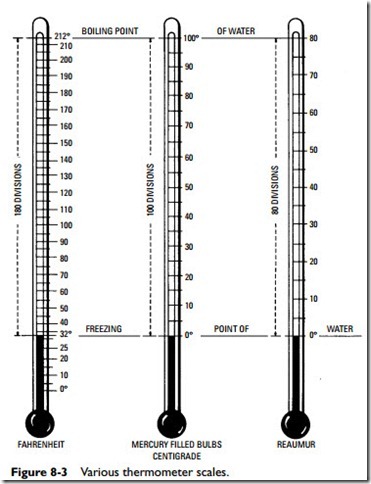Measuring the Physical Properties of Air
A number of instruments are used for measuring the physical properties of air. These include the following:
1. The thermometer
2. The barometer
3. The psychrometer
4. The pressure gauge
A thermometer (see Figures 8-2 and 8-3) is a device used to mea- sure temperature, and consists of a glass tube terminating in a bulb charged with mercury or colored alcohol. It measures the temperature by the contraction or expansion of the liquid with temperature
changes, causing the liquid to rise or recede in the tube. The scale of an ordinary thermometer, either Fahrenheit or Celsius, is simply an arbitrary standard by means of which comparisons can be established.
An ordinary thermometer is used to measure dry-bulb temperature. Dry-bulb temperature is the degree or intensity of heat. In other words, dry-bulb temperature measures the degree of effort that the heat will exert to move from one position to another.
A specially designed thermometer is used to measure wet-bulb temperature. The latter represents the temperature at which the air becomes saturated if moisture is added to it without a change of heat. The bulb of an ordinary thermometer is surrounded with a moistened wick, placed in a current of air, and superheated with water vapor. Essentially this represents a wet- bulb thermometer.
A barometer (see Figure 8-4) is an instrument designed to measure atmospheric pressure. Early barometers consisted of a 30-inch-long glass tube open at one end and filled with mercury. The open end was submerged in a bowl of mer- cury, and the mercury in the glass tube would assume a level in accordance with the existing atmospheric pressure. Thus, the height of the mercury column in the tube is a measure of the atmospheric pressure. Standard atmospheric pressure at sea level is 29.921 inches of mercury.
A psychrometer (or sling psychrometer) is an instrument used to measure relative humidity. It consists of a dry-bulb (for air temperature) and a wet-bulb thermometer mounted side by side. The reading on the wet-bulb thermometer is determined by the rate at which the moisture evaporates from its bulb. If the psychrometer is working correctly, the reading on the wet-bulb thermometer will be lower than the one on the dry-bulb thermometer. The difference between the two readings serves as a basis for determining the relative humidity.
Pressure gauges (see Figures 8-5, 8-6, and 8-7) are used to mea- sure pressure. A high-pressure gauge (see Figure 8-5) is used to measure pressures ranging from zero to 300 or 400 psig. A com- pound gauge (see Figure 8-6) is used to measure low pressures
above atmospheric pressure in psig and below atmospheric pressure in vacuum in inches of mercury.

